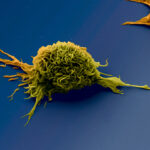Link to Pubmed [PMID] – 34910930
Link to DOI – 10.1016/j.immuni.2021.11.008
Immunity 2022 Jan; 55(1): 129-144.e8
Dendritic cells (DCs) patrol tissues and transport antigens to lymph nodes to initiate adaptive immune responses. Within tissues, DCs constitute a complex cell population composed of distinct subsets that can exhibit different activation states and functions. How tissue-specific cues orchestrate DC diversification remains elusive. Here, we show that the small intestine included two pools of cDC2s originating from common pre-DC precursors: (1) lamina propria (LP) CD103+CD11b+ cDC2s that were mature-like proinflammatory cells and (2) intraepithelial cDC2s that exhibited an immature-like phenotype as well as tolerogenic properties. These phenotypes resulted from the action of food-derived retinoic acid (ATRA), which enhanced actomyosin contractility and promoted LP cDC2 transmigration into the epithelium. There, cDC2s were imprinted by environmental cues, including ATRA itself and the mucus component Muc2. Hence, by reaching distinct subtissular niches, DCs can exist as immature and mature cells within the same tissue, revealing an additional mechanism of DC functional diversification.



